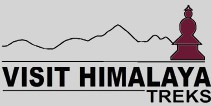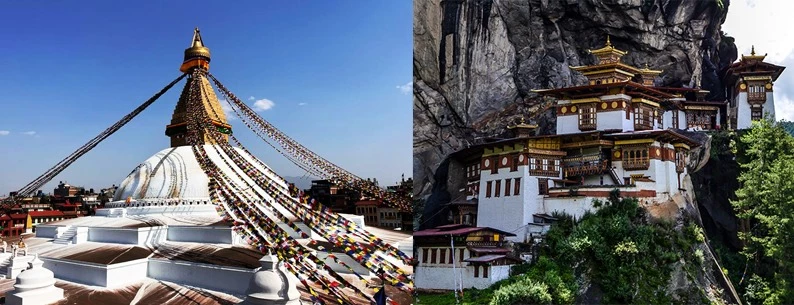A privately guided tour of cultural heritage sites in Nepal and Bhutan offers you a rich experience of the culture, spirituality, and local lifestyle.
A privately guided tour of cultural heritage sites in Kathmandu offers you a rich experience of the culture, spirituality, and local lifestyle. You will explore ancient temples and stupas like Swoyambhunath, Boudhanath, and Pashupatinath to have an idea of how spiritual the Nepalese people are.
For a cultural understanding of this beautiful place, you will visit places like Durbar Squares in Kathmandu Valley – Kathmandu Durbar Square, Patan Durbar Square, and Bhaktapur Durbar Square. These places will give you a deeper understanding and experience of the Kathmandu Valley lifestyle.
In addition to the cultural exploration, you will also get to enjoy the beautiful nature and view of mountains. When you are in Nagarkot, you can enjoy a panoramic view of the Himalayas and a beautiful sunrise over them. The natural surroundings of Nagarkot will simply overwhelm you. The journey leads you to picturesque Pokhara famous and popular destination in all Himalayas where you can marvel at beautiful Annapurna Himalaya in the comfort of nice hotels by the pristine Phewa Lake.
The Chitwan National Park is situated in southwestern Nepal and covers 932 sq. km. This is Nepal’s first famous national park for wildlife safaris. It is the home of the one-horned rhinoceros and harbors one of the largest populations of the exclusive and rare Royal Bengal tigers, wild elephants; white-footed gaur (the world’s largest wild cattle), leopards, wild boar, sloth bear, and several species of deer including the spotted barking sambar, and hog deer.
The swampy areas and numerous oxbow lakes are perfect for marsh crocodiles. The park hosts 450 species of birds. The Tharu people have unique cultural traditions.
Bhutan the Place of Happiness,
Nestled in the folds of the Eastern Himalayas, remaining in self-imposed isolation for centuries, Bhutan opened up to the world at a glacial pace. The population lived in close harmony with nature, evolving a unique identity, derived largely from a rich religious and cultural heritage. This country of 700,000 people, roughly the size of Switzerland, is the world’s only Mahayana Buddhist country. The Buddhist respect for all sentient beings helped Bhutan protect its pristine ecology and wildlife.
This self-sufficient population was never colonized and had limited contact with the outside world. Buddhism was established in the 8th century by the Indian saint Padmasambhava, popularly known in the Tantric tradition as Guru Rinpoche. Perhaps the most dynamic era in Bhutanese history came in the 17th century with the arrival, in 1616, of Zhabdrung Ngawang Namgyal, the great leader of the Drukpa school of Mahayana Buddhism. He unified the country and established the foundations for national governance and the Bhutanese identity.
In 1907, a historic Assembly of the clergy, the official administration, and the people unanimously elected Gongsar Ugyen Wangchuck as the first hereditary King of Bhutan thus beginning the glorious era of the Wangchuck dynasty. In 2006, the fourth king of Bhutan, Jigme Singye Wangchuck announced that he would abdicate in favor of a constitutional monarchy with a parliamentary democracy. In 2008, the year that marked 100 years of the monarchy saw two important events; the first democratic elections and the coronation of the fifth king, Jigme Khesar Namgyel Wangchuck.
The Best of Nepal & Bhutan Tour Itinerary,
Day 01: Arrival at KTM Airport, receive at KTM airport, and transfer to hotel stay overnight at Hotel KTM. (1350 meters)
Day 02: After Breakfast, Full day sightseeing in the KTM world heritage site, with a Historical City Guide, and stay overnight at Kathmandu Hotel. (1350 meters)
Day 03: Full-day sightseeing stays overnight at Nagarkot. (2100 meters)
Day 04: Nagarkot - Pokhara drive and stay overnight at Pokhara. (822 meters)
Day 05: Sightseeing in Pokhara, Late afternoon boating at Fewa Lake stay overnight at Pokhara at Hotel. (822 meters)
Day 06: Sarangkot View Point and drive to Chitwan National Park. (415 meters)
Day 07: Full-day Activities in Chitwan National Park. (415 meters)
Day 08: After Breakfast Drive back to Kathmandu. (1350 meters)
Day 09: Fly to Paro & Transfer to Thimphu (55 KMS/ 1:30 hours’ drive. (2334 meters)
Day 10: Thimphu and around. (2334 meters)
Day 11: Thimphu to Punakha (75 KMS 3 hours’ drive. (1242 meters)
Day 12: Punakha – Paro (120 KMS 5 hours’ drive. (2200 meters)
Day 13: Visit Paro and Around. (2200 meters)
Day 14: Fly to Kathmandu from Paro. (1350meters)
Day 15: Departure. (1350 meters)
Best time to visit Nepal and Bhutan.
Autumn season:
October and November are considered the best months for a visit to Nepal. The main festivals of Dashain and Tihar (two important Hindu festivals) are being celebrated during these months. The skies remain clear for great views and the temperature is pleasant for trekking and touring.
Spring season:
March to May is also a good time to visit as the rhododendrons are then in full bloom on the hills. December to mid-February is suited for travels well below the tree line and die-hard adventurists, looking for extreme situations higher up!



